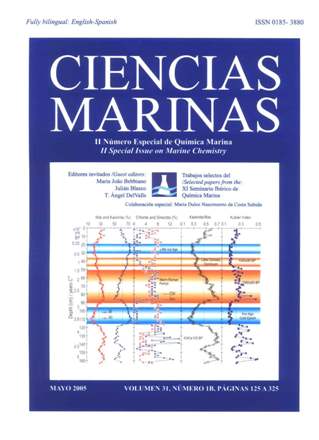Net autotrophy and heterotrophy in the Pontevedra Ria upwelling system (NW Iberian margin)
Main Article Content
Abstract
A non-stationary state mass balance of the type advocated by the International Geosphere-Biosphere Programme/Land-Ocean Interactions in the Coastal Zone (IGBP/LOICZ) has been used to assess net ecosystem metabolism in the Pontevedra Ria (NW Spain), a large embayment subject to transient upwelling of Eastern North Atlantic Central Water (ENACW) under favourable meteorological conditions. Nitrate (NO3–) and phosphate (PO43–) data spanning 12 months were resolved at the oceanic boundary by treating the ria as a single box of constant volume. The nutrient budget was scaled up to an estimate of net community production (NCP) using the compositional relationship of local phytoplankton. The mean annual NCP predicted by the NO3– balance was 24.0 mgC m–2 h–1, and 35.8 mgC m–2 h–1 by the PO43– budget. Nutrient fluxes into the reservoir were strongly driven by the incoming oceanic flow throughout the year, which supplied 88% and 98% of the total NO3– and PO43– load, respectively. A high NCP (NO3–) of 57.2 mgC m–2 h–1 was calculated for the height of the growth season contemporaneous with ENACW intrusion, whereas a slightly higher value of 61.4 mgC m–2 h–1 corresponded to PO43–. Nutrient limitation was variable throughout the sampling, switching from PO43– to NO3– from winter to spring concurrent with a drop in riverine PO43– input. Scaling the inorganic nutrients to carbon units, the Pontevedra Ria may be considered as net autotrophic, although the NO3– budget suggests alternation between autotrophy and heterotrophy over an annual cycle.
Downloads
Article Details

This work is licensed under a Creative Commons Attribution 4.0 International License.
This is an open access article distributed under a Creative Commons Attribution 4.0 License, which allows you to share and adapt the work, as long as you give appropriate credit to the original author(s) and the source, provide a link to the Creative Commons license, and indicate if changes were made. Figures, tables and other elements in the article are included in the article’s CC BY 4.0 license, unless otherwise indicated. The journal title is protected by copyrights and not subject to this license. Full license deed can be viewed here.

